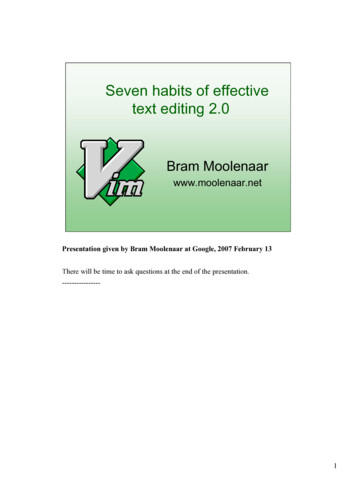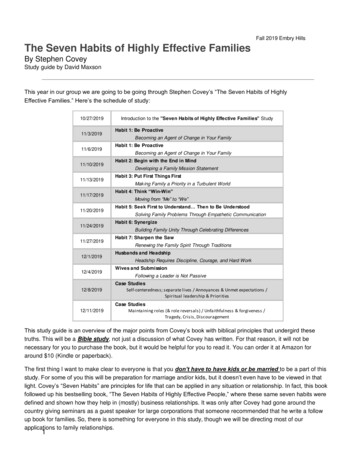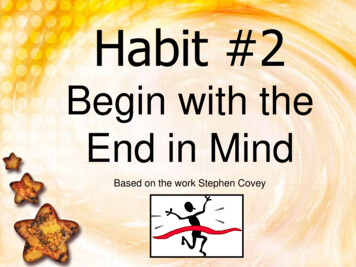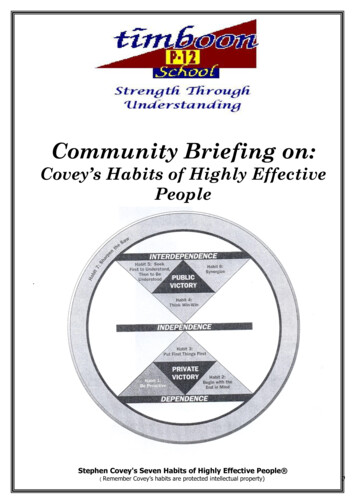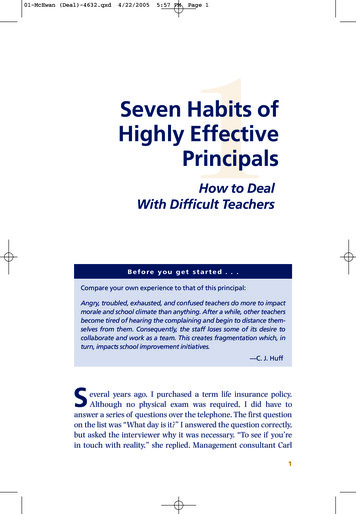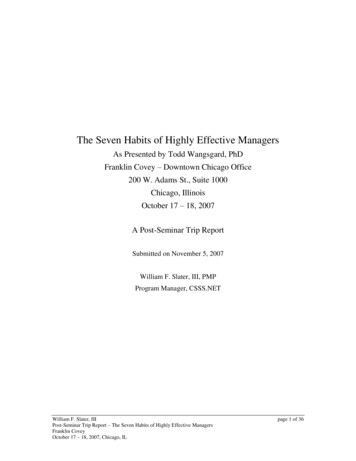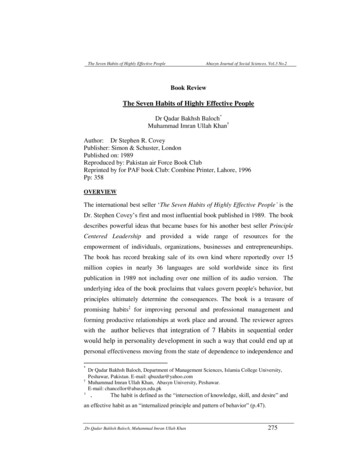
Transcription
The Seven Habits of Highly Effective PeopleAbasyn Journal of Social Sciences. Vol.3 No.2Book ReviewThe Seven Habits of Highly Effective PeopleDr Qadar Bakhsh Baloch*Muhammad Imran Ullah Khan†Author: Dr Stephen R. CoveyPublisher: Simon & Schuster, LondonPublished on: 1989Reproduced by: Pakistan air Force Book ClubReprinted by for PAF book Club: Combine Printer, Lahore, 1996Pp: 358OVERVIEWThe international best seller ‘The Seven Habits of Highly Effective People’ is theDr. Stephen Covey’s first and most influential book published in 1989. The bookdescribes powerful ideas that became bases for his another best seller PrincipleCentered Leadership and provided a wide range of resources for theempowerment of individuals, organizations, businesses and entrepreneurships.The book has record breaking sale of its own kind where reportedly over 15million copies in nearly 36 languages are sold worldwide since its firstpublication in 1989 not including over one million of its audio version. Theunderlying idea of the book proclaims that values govern people's behavior, butprinciples ultimately determine the consequences. The book is a treasure ofpromising habits‡ for improving personal and professional management andforming productive relationships at work place and around. The reviewer agreeswith the author believes that integration of 7 Habits in sequential orderwould help in personality development in such a way that could end up atpersonal effectiveness moving from the state of dependence to independence and*†‡Dr Qadar Bakhsh Baloch, Department of Management Sciences, Islamia College University,Peshawar, Pakistan. E-mail: qbuzdar@yahoo.comMuhammad Imran Ullah Khan, Abasyn University, Peshawar.E-mail: chancellor@abasyn.edu.pk.The habit is defined as the “intersection of knowledge, skill, and desire” andan effective habit as an “internalized principle and pattern of behavior” (p.47).,Dr.Qadar Bakhsh Baloch, Muhammad Imran Ullah Khan275
The Seven Habits of Highly Effective PeopleAbasyn Journal of Social Sciences. Vol.3 No.2then interdependence. The book is organized in to this book into four parts asfollows: Part-I titled as Paradigms and Principles presents a brief overview of theSeven Habits and sets stage for the subsequent debate on the proposedseven habits. Part-II titled as Private Victory presents first three habits defining threesets of principles; principles of personal vision, personal leadership andpersonal management. Skillful use of these three habits can take a personfrom dependence to independence, or self-reliant mode. Part-III under the heading of Public Victory and Renewal groups threehabits (habit 4 to habit 6) emphasizing paradigms of interdependence.According to Covey this paradigms of interdependence is centered alongprinciples of interpersonal leadership, emphatic communication, andprinciples of creative cooperation. Part-IV explains habit number seven that describes principles of balancedself-renewal.,Dr.Qadar Bakhsh Baloch, Muhammad Imran Ullah Khan276
The Seven Habits of Highly Effective PeopleAbasyn Journal of Social Sciences. Vol.3 No.2REVIEWWe are what we repeatedly do.Excellence, then, is not an act, but a habit.AristotleParadigms & PrinciplesThis part of the book describes paradigms, principles and some concepts forthe people to understand in order to grasp the success in a most effective way.The Paradigm is a lens we see the happenings around, perceive, understand andinterpret according to our perceptions. The Oxford and other English Dictionaryoffer its meaning as; pattern, archetype, model, example, standard, theory,perception, assumption, or frame of reference. In a more general sense, it is theway we see the world in terms of perceiving, understanding, and interpreting.The paradigm may be based on reality i.e. the way things are, or values; the waythings should be.However, as Einstein (Covey, 1989) observed that thesignificant problems we face cannot be solved at the same level of thinking wewere at when we created them. This new thinking is called a paradigm shift§. Aparadigm shift is when we abandon an incorrect paradigm for a correct one.According to Kuhn (1962) every significant break through in the field ofscientific endeavor is a first a break with tradition, with old ways of thinking,with old paradigms. And the key to effectiveness is in locating and maintainingcorrect paradigm by keeping eyes, ears and mind open with the believe that thereis always more to the picture we see.Principles can be defined as natural laws that are self evident and part ofhuman consciousness (p.32). Dr Covey surveyed success literature of over last200 years and concluded that the success of last 150 years can be attributed to the‘character ethics. These character ethics are the absolute Principles that governhuman effectiveness and serve as foundation of true success. They result in to§.the term Paradigm shift was introduced by Thomas Kuhn in his book ‘TheStructure of Scientific Revolution’,Dr.Qadar Bakhsh Baloch, Muhammad Imran Ullah Khan277
The Seven Habits of Highly Effective PeopleAbasyn Journal of Social Sciences. Vol.3 No.2enduring happiness provided; people integrate these principles in to their basiccharacter. Principles are not abstruse practices or impenetrable values but have auniversal application. The numbers of principles enumerated in this part of thebooks are (p.18): FairnessIntegrity/honestyHuman dignityQuality/excellencePotentialCourage tThe foremost key concept that author deliberates upon is “inside-out”, whichalso serves as the title of the first chapter. The ‘in-side’ approach encapsulatesthat in order to change the situation; we first had to change ourselves. And tochange ourselves effectively, we first had to change our perceptions (p.18).The effectiveness is defined by the term ‘P/PC Balance’. Here ‘P’ stands forproduction or desired results, and ‘PC’ stands for production capability, theability or asset (physical asset, financial asset, or human asset) that produce thedesired results. Hence, effectiveness is a balance that brings equilibriumbetween the two. In case of imbalance or disequilibrium between the systemwill tilt on one side and effectiveness would be reduced.Though image, techniques and skills can influence outward success however,the weight of real effectiveness lies in good character. A person with highcharacter exhibits integrity, maturity and an abundance mentality. A personwith high competence has knowledge and ability in a given area. And balancein character and competence builds personal trustworthiness and their trust withothers.,Dr.Qadar Bakhsh Baloch, Muhammad Imran Ullah Khan278
The Seven Habits of Highly Effective PeopleAbasyn Journal of Social Sciences. Vol.3 No.2The other key concept defined in the book is the Maturity Continuum which statesthat the effective application of the seven habits moves a person progressively on acontinuum from dependence to independence to interdependence. The first threehabits move a person from the state of dependence to the independence state, andnext three habits move an independent person to interdependence with otherindependent person in a synergy. Every one begins its life as infant totally dependentupon others. With gradual nurturing the one becomes more independent-physically,mentally, emotionally, and financially. As, one continues to grow and mature,becomes aware that all of nature is interdependent.,Dr.Qadar Bakhsh Baloch, Muhammad Imran Ullah Khan279
The Seven Habits of Highly Effective PeopleAbasyn Journal of Social Sciences. Vol.3 No.2Private Victory:Private Victory denotes to three step spiral process of conscious growth;mastering commitment, learning and doing. These private victories will allowus to break through any dependency we have towards others and allow for fullinterdependency within our lives. However, this process of change is attainedthrough Habits 1-3:Habit 1 – Being ProactiveHabit 2 – Begin with the end in mindHabit 3 – Put first things firstHabit 1: Be Proactive-Principle of Personal Vision: Proactively is theindividual or group response to make choices based on their self awareness,creativity and independent will. Being proactive means taking initiative, notwaiting for others to act first, and being responsible for what you do.Ourlife doesn’t just happen, rather intentionally or un-intentionally it is designed byus. Therefore, being proactive is the endowment of awareness. Be Proactive isabout taking responsibility for your life and choosing behavior. Proactivepeople recognize that they are "response-able" and don’t blame genetics,circumstances, conditions, or conditioning for their behavior. They know theychoose their behavior. Whereas, reactive people are often affected by theirphysical environment and find external sources to blame for their behavior.Since, environmental stimulus dominates choice and responsetherefore; most people take an outside-in approach. Hence, Covey categorizespeople response to stimuli into two areas: Re-active focus and Pro-active focus.Proactive people focus their efforts on their Circle of Influence. They work onthe things they can do something about: health, children, and problems at work.Reactive people focus their efforts in the Circle of Concern--things over which,Dr.Qadar Bakhsh Baloch, Muhammad Imran Ullah Khan280
The Seven Habits of Highly Effective PeopleAbasyn Journal of Social Sciences. Vol.3 No.2they have little or no control: the national debt, terrorism, the weather. Gainingan awareness of the areas in which we expend our energies in is a giant step inbecoming proactive. According to Covey, proactively is grounded in facingreality but also understanding we have the power to choose a positive responseto our circumstances.Habit- 2: Begin with the End in Mind: To begin with the end in mind meansto have clear understanding of your destination and where you are at now. Habit2 is endowment of imagination and conscience. It is envisioning in mind whatone cannot see with his eyes. It is based on the principle that all things arecreated twice; firstly creation in mind and then physical creation. Begin withthe End in Mind means to begin each day, task, or project with a clear vision ofyour desired direction and destination, and then continue by flexing yourproactive muscles to make things happen. Therefore, Habit 2 puts your goals infocus, and moves your ideas into the real world. You create your own destinyand secure the future you envision.Habit 3: Put First Things First:It is the Principles of PersonalManagement once one moves from state of dependency to independency. This,Dr.Qadar Bakhsh Baloch, Muhammad Imran Ullah Khan281
The Seven Habits of Highly Effective PeopleAbasyn Journal of Social Sciences. Vol.3 No.2habit builds on the previous two and the actual exercise of independent will tocreate a life congruent with your values, goals and mission. Covey suggests,we should lead from the right brain (creatively) and manage from the left brain(analytically). To set the context for effective management, he discusses whathe refers to as the fourth human endowment, Independent Will, which is theability to make decisions and choices and act upon them.He also notesintegrity, our ability to make and keep commitments to ourselves, as importantto effective personal management. Time management is an essential skill forpersonal management. The essence of time management is to organize andexecute around priorities. Covey presents a matrix made of the characteristicsof activities, classifying them as urgent or not urgent, important or notimportant. List the activities screaming for action as "Urgent." List the activitiescontributing to your mission, value or high-priority goals as "Important." Thefollowing are some of his descriptions of each quadrant of the matrix: Quadrant I activities are urgent and important - called problems orcrises. Focusing on Quadrant I results in it getting bigger and biggeruntil it dominates you. Quadrant II activities are important, but not urgent. Working on thisQuadrant is the heart of personal time management. Quadrant III activities are urgent and not important, and oftenmisclassified as Quadrant I. Quadrant IV is the escape Quadrant - activities that are not urgent andnot important.Effective people stay out of Quadrants III and IV because they aren'timportant. They shrink Quadrant I down to size by spending more time inQuadrant II.,Dr.Qadar Bakhsh Baloch, Muhammad Imran Ullah Khan282
The Seven Habits of Highly Effective PeopleAbasyn Journal of Social Sciences. Vol.3 No.2Habit 3 is all about life management, prioritizing about what are "first things?"If you put first things first, you are organizing and managing time and eventsaccording to the personal priorities you established in Habit 2.Public Victories:Public victory evolves paradigms of interdependence. Covey stressesthat private victory precedes public victory. Hence, effective interdependencecan only be built upon the foundation of true independence. Public victoriescreate harmony and synergy in our relationships with others. This process ofgrowth is formed by working on habits four through six:Habit 4 – Think win/winHabit 5 – Seek first to understand Then to be understoodHabit 6 – SynergizeHabit 4: Think Win/Win-Principles of Interpersonal Leadership:Inwin/win situation people seek mutual benefit in all interactions. Win-win doesnot focus on competition rather on a corporate arena. Win-win meansagreements that are mutually beneficial and satisfying. Covey clarifies his viewon competition and the win/win paradigm as follows:“Competition has its place against market competitors, last year'sperformance, or another location or individual where cooperationand interdependence aren't required, but cooperation in theworkplace is as important to free enterprise as competition in themarketplace. The spirit of Win/Win cannot survive in anenvironment of competition or contests. All of the company'ssystems should be based on the principle of Win/Win. TheCompensation system of the managers should be based on the,Dr.Qadar Bakhsh Baloch, Muhammad Imran Ullah Khan283
The Seven Habits of Highly Effective PeopleAbasyn Journal of Social Sciences. Vol.3 No.2productivity and development of their people. Reward both P(production) and PC (building production capacity)” (p.230)The five dimensions of the Win/Win model s described by the author are: Character is the foundation of Win/Win. There must be integrity in orderto establish trust in the relationship and to define a win in terms of personalvalues. A key trait is the abundance mentality that there is plenty foreverybody (v. the Scarcity Mentality). The abundance mentality flows froma deep inner sense of personal worth and security. Relationships are the focus on Win/Win. When there is a relationship oftrust and emotional bank account balances are high, there is a much greaterprobability of a successful, productive interaction. Negative energy focusedon differences in personality or position is eliminated; positive, cooperativeenergy focused on understanding and resolving issues is built. Performance agreements or partnership agreements give definition anddirection to Win/Win. They shift the paradigm of production from vertical(Superior - Subordinate) to horizontal (Partnership/Team). The agreementshould include elements to create a standard by which people can measuretheir own success and clearly contain: results, guidelines, resources,accountability, and consequences. The Reward System is a key element in the Win/Win model. TalkingWin/Win but rewarding Win/Lose results in negating the Win/Winparadigm. If the outstanding performance of a few is rewarded, the otherteam members will be losers. Instead, develop individual achievable goalsand team objectives to be rewarded.,Dr.Qadar Bakhsh Baloch, Muhammad Imran Ullah Khan284
The Seven Habits of Highly Effective PeopleAbasyn Journal of Social Sciences. Vol.3 No.2Principles Interpersonal Leadership3. Win-Win AgreementTRUST2. Skills– What a person can do 6. rolPlanning/OrganizationSynergistic Problem Solving1. Character– What a person is Integrity ( Habits Values andWords DeedsMaturity (Courage Balanced withConsideration)Abundance Mentality4. Self-SupervisionPlan5. Helpful Structures andSystemsHabit 5: Seek first to understand then to be Understood- Principles ofEmpathic Communication.The root cause of almost all people problems is the communicationproblem because most of the time people don’t listen with empathy. By seekingfirst to understand, one has to get on the same side of the table looking at theproblem instead of staying on opposite sides staring at each other. One of themost basic steps in seeking to understand is properly listening. People usually"listen" at one of four levels: ignoring, pretending, selective listening, orattentive listening.The ability to listen requires restraint and veneration, andability to make your self understood requires and consideration (Covey, 1992,42). Covey (1989) suggests that we should be using the fifth, highest form oflistening - empathic listening. Empathic listening is listening with intent to,Dr.Qadar Bakhsh Baloch, Muhammad Imran Ullah Khan285
The Seven Habits of Highly Effective PeopleAbasyn Journal of Social Sciences. Vol.3 No.2understand the other person's frame of reference and feelings. You must listenwith your ears, your eyes and your heart. By understanding the other person,one can learn their paradigms through which they view the world and theirneeds. Then we can try to resolve our differences to work together.Knowing how to be understood is the other half of the Habit5 and is equallycritical in reaching win/ win situation. The author uses the Greek philosophy ofEthos, Pathos, and Logos to establish the sequence for effectivecommunication. Ethos is your creditability, the faith people have in yourintegrity and competency. Pathos is the feeling of the emotional thrust of theother person’s communication. Logos is the reasoning and logic side of thepresentation (255). This Greek philosophy of ethos, pathos and logos arrangesyour character- relationship and the logic of the presentation- which is aparadigm shift in routine communication. When you can present your ownideas clearly, specifically, visually and most importantly contextually - in the,Dr.Qadar Bakhsh Baloch, Muhammad Imran Ullah Khan286
The Seven Habits of Highly Effective PeopleAbasyn Journal of Social Sciences. Vol.3 No.2context of a deep understanding of their paradigms and concerns - yousignificantly increase the creditability of your ideas.Habit 6: Synergize- Principles of Creative Cooperation:The synergy isthe creative achievement of the previous habits because if the sevenhabits are used together then the result is very powerful. Communicationand cooperation are two legs of synergy. The essence of synergy is tovalue the mental, emotional, and psychological differences betweenpeople. Synergy builds a closely knit team with a high emotional bankaccount of trust. High trust generates upper level of cooperation and opencommunication. To produce synergy, the concepts of win/win, mutualunderstanding and seeking synergy are used to work directly on therestraining forces.According to Covey synergy means; The whole is greater than the sum of its parts. It means that therelationship which the parts have to each other is part in and of itselfthe most empowering, unifying and exciting part” (p.263).,Dr.Qadar Bakhsh Baloch, Muhammad Imran Ullah Khan287
The Seven Habits of Highly Effective People Abasyn Journal of Social Sciences. Vol.3 No.2The essence of synergy is to value differences- to respect them, tobuild strengths, and to compensate for weaknesses” (p. 263).Synergy can be unnerving unless one has a high tolerance forambiguity and gets security from integrity to principles and innervalues.To achieve synergy in business requires that people become open andauthentic. When we open ourselves up to the influence of others, wegain new insights and facilitate the generation of new options.Habit 7: Sharpen the Saw- Principles of Balanced Self-Renewal: Thishabit is focused on renewing the four dimensions of human nature; physical,spiritual, mental and social/emotional, so that one can work more quickly andeffortlessly: The physical dimension involves eating the right foods, getting enoughrest and relaxation, and exercising on a regular basis. A good programbuilds your body's endurance, flexibility and strength. The spiritual dimension is your center, your commitment to your valuesystem. It draws upon the sources that inspire and uplift you and tie youto timeless truths of humanity. The mental dimension, important keeps your mind sharp by reading,writing, organizing and planning. Emotional life is primarily developed out of and manifested in ourrelationships with others. Renewing our social/emotional dimensionrequires focus and exercise in our interaction with othersRenewal is the principle and process that empowers a person to move on anupward spiral of growth and change, of continuous improvement Self-renewalmust include balanced renewal in all four dimensions in individual ororganizational context.The things done to sharpen the saw in any onedimension have a positive impact in the other dimensions, because they are sohighly interrelated. .,Dr.Qadar Bakhsh Baloch, Muhammad Imran Ullah Khan288
The Seven Habits of Highly Effective PeopleAbasyn Journal of Social Sciences. Vol.3 No.2ReferencesCovey R. Stephen, (1989) the Seven Habits of Highly Effective People, Lahore,PAF Book ClubCovey R. Stephen, (1991) Principle Centered Leadership, Simon & Schuster,LondonKuhn Thomas (1962) the structure of Scientific Revolution, University ofChicago PressSmith M.Perry (2002) Rules and Tools for Leaders, Perigee Book BerkeleyPublishing, New York,Dr.Qadar Bakhsh Baloch, Muhammad Imran Ullah Khan289
The Seven Habits of Highly Effective People Abasyn Journal of Social Sciences. Vol.3 No.2,Dr.Qadar Bakhsh Baloch, Muhammad Imran Ullah Khan 279 The other key concept defined in the book is the Maturity Continuum which states that the effective application of th

